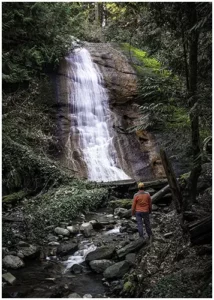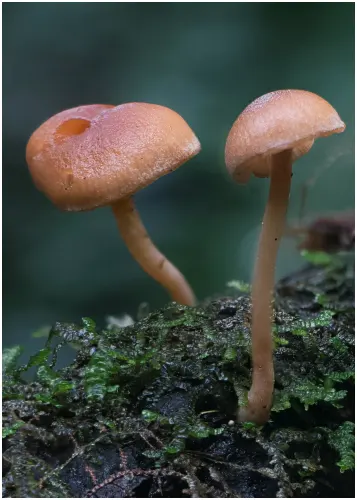
The Charming Northfield Falls in the Heart of Beach Estate Park
Looking to kill off an hour while in Nanaimo, BC? Just a short hop-skip and


Take your images to jaw-dropping heights with Luminar Neo focus stacking? Brace yourself for a thrilling journey into the world of photography magic! In this article, we will reveal the hidden potential of Luminar Neo’s remarkable focus stacking features. From Auto Alignment and chromatic aberration reduction, we’ll also discuss Neo other extensions to help you create stunning, one-of-a-kind masterpieces. Get ready to unleash your creative prowess – it’s time to dive into the captivating world of Luminar Neo focus stacking!
Focus Stacking is a method where you merge multiple images with slightly different focus points to create a greater depth of field. Imagine taking a series of photos of an insect or mushrooms, with each photo on a different focal plane. By merging these images, you create one highly detailed sharply in focus photo. This technique is particularly useful in macro and product photography, making your photos pop with detail.
Imagine taking flawless macro photos at any aperture, capturing every tiny detail as the world freezes for your camera. Shooting small subjects can be quite challenging. However, with Focus Stacking in Luminar Neo, you’ll find it so easy to achieve precise focus that you’ll wonder how you ever did it before. Neo can blend up to 100 photos with ease. No more juggling focuses for each photo – let the software’s AI algorithm select the sharpest parts to deliver stunning images.
With Luminar Neo’s Focus Stacking feature, you can effortlessly eliminate the hassle of manually merging images that have different focal points. The result? You get photos that are sharp from the foreground to the background – a feature that truly enhances my landscape and macro photography.
Think of it like this – you’ve clicked several photos of the same scene, each with a different focus point. Now, instead of spending hours in post-production, Luminar Neo does it all for you in just a few clicks!
Importing photos to Luminar Neo is easy! Here’s a simple step-by-step guide:
You can skip this step if you use Adobe Lightroom.
Press and hold the Ctrl + A key on Windows or Command + A on Mac to quickly select all the photos in a folder. Then, simply drag and drop them into the Focus Stacking window located on the right-hand side. A practical tip: use the shift key to select the first and last image in a series to quickly highlight all. Remember, you can scroll through your images or remove any unnecessary ones at this stage.
The third step in focus stacking with Luminar Neo involves choosing your settings.
Remember, the correct settings can thoroughly enhance your images, revealing details while maintaining a natural look.
Applying the finishing touches to your focus-stacked images in Luminar Neo is key to elevating your photographs to the next level. Here’s a quick guide to do it effectively:
Remember, the right finishing touches can reveal incredible detail while maintaining the natural appeal of your images.
Now you’ve effortlessly performed focus stacking in Luminar Neo using your Adobe Lightroom images!
Focus stacking might sound a bit complicated, but it’s actually quite simple once you get the hang of it. Here’s how to do it step by step:
Remember, the more photos stacked, the longer it takes, but the result is a razor-sharp image worth the wait!
Darn! You Nikon – Some cameras have an option built-in for focus stacking. If your camera does, please remember to check if it produces a RAW of Jpeg image as the final result.
They’re not necessary, but I would highly recommend a macro lens. Using a macro lens for focus stacking opens up a whole new world of incredible close-up photography! When you want to capture tiny subjects, like bugs, flowers, or small objects, a macro lens becomes your secret weapon. Here’s why and how it works:
With a macro lens and focus stacking, you’ll reveal the hidden beauty of the tiniest wonders in nature and objects, making your photography truly mesmerizing!
If you’re new to the world of photo editing, one can’t ignore the capabilities of Luminar Neo. Not only has it revolutionized post processing, but its focus stacking extension is unrivalled.
Luminar Neo greatly simplifies focus stacking by allowing you to stack up to 100 photos and seamlessly blend them for maximum depth and details. No longer do you need to painstakingly align and mix images manually. Its AI algorithms do all the heavy lifting, effortlessly merging multiple photos.
Luminar Neo’s blend of intuitive design and powerful AI tools means users can achieve professional results with minimal effort and time, truly a game changer for focus stacking.
Through Neo’s advanced AI capabilities, this software packs an impressive combination of power and precision. With Focus Stacking, you can combat the common issue of mis-focus. The AI-driven tools don’t stop there; from AI Noise removal to SuperSharp AI, these intuitive features help streamline your editing process.
The Auto Alignment feature in Luminar Neo’s Focus Stacking extension utilizes cutting-edge AI technology, delivering precision, and saving you time.
Its advantages are numerous. For starters, it ensures seamless alignment of multiple photographs. This is especially beneficial when dealing with images that have a mixture of highlights and shadows. Auto Alignment distinguishes these contrasts and adjusts accordingly, ensuring your final image is harmonized.
Shooting vivid landscapes or intricate macro photography? You can now capture every detail. The petal on a flower or a majesty of distant mountains – Focus Stacking ensures an evenly distributed focus throughout your image.
As an added bonus, your stacked image will be delivered in Tiff format, allowing you to further refine the results as per your preference.
Neo, has made a giant leap with improved AI algorithms! These enhancements, especially SuperSharp AI, allow you to work wonders with focus stacking. Unlike traditional sharpening, SuperSharp AI goes beyond simple edge contrast. It tackles issues like poor focus and motion blur head-on, redefining sharpness across your entire photo.
With recent upgrades, SuperSharp AI now includes a unique Motion Blur correction and a Face Enhancer. These thoughtful enhancements further streamline your focus-stacking process. Despite some shortcomings compared to Topaz Sharpen AI, SuperSharp AI blends into your Luminar Neo workflow beautifully, making it a worthy addition.
With Luminar Neo’s AI-driven features, focus stacking becomes less of a chore and more of a breeze, helping you achieve crystal-clear images with ease.
Breathe life into your images once the focus stacking is complete. Whether tweaking tonal contrasts, controlling light and shadow, or refining colour and structure. Neo’s seamless blending of cutting-edge technology tailored to elevate your photos. Intrigued? You should be!
Features that will revolutionize your photo editing experience include:
If you’re a photography freak like me, then you’ll definitely love the ease of using Luminar Neo focus stacking extension. This incredible extension simplifies and automates various tasks like alignment, correcting lens and chromatic aberrations. This streamlines the focus stacking process, leaving you more time to do what you love. Keep shooting.
Yes, you can do focus stacking in Luminar Neo. It allows you to combine multiple images with different focus points to achieve a fully sharp and detailed final result.
To achieve focus stacking, set your camera to aperture priority mode, choose a small aperture (e.g., f/8 to f/16), and manually focus on the nearest subject. Capture multiple shots with different focus points and blend them in Luminiar Neo to achieve sharpness in the photo
Focus stacking software is require for sharp, detailed images in macro photography. It combines multiple shots with different focus points into one fully focused image, ensuring every tiny detail is crystal clear.

Looking to kill off an hour while in Nanaimo, BC? Just a short hop-skip and

Photography can be a fulfilling and enjoyable hobby that brings a creative outlet to your

Welcome to our guide to Photoshop tutorials for beginners: A Complete Beginner’s Tutorial for Learning